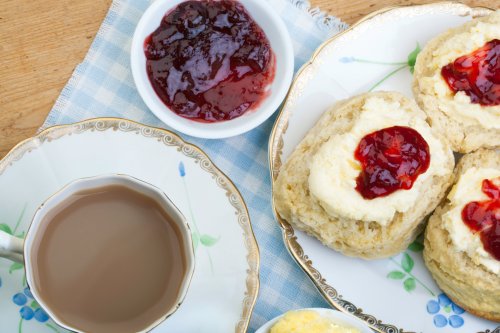Donate to THT
Born in Tavistock: The History of the Devonshire Cream Tea

One of the best places in England to enjoy a delicious cream tea is Tavistock where legend has it that the very first ‘cream teas’ were served over a 1,000 years ago by the monks of the Abbey.
It is said that when Tavistock Abbey was being re-built after being plundered and badly damaged by a band of marauding Vikings in 997AD, the monks were so grateful to the local workers who helped them rebuild it that they rewarded them with bread and ‘clowted cream’. Apparently, this fare proved so popular that the monks continued to serve the treat to passing travellers. In fact, the now blocked up window under Court Gate is said to be where they handed out these delights.
So what would a 10th century cream tea have looked like?
Well for a start there obviously wouldn’t have been any tea with it, tea didn’t arrive in England until the 17th century when it was introduced via the coffee houses. It first became popular in the 1800s when it was being shipped in by the ton by the East India Company using streamlined clipper ships like the Cutty Sark.
There would certainly have been cream though, ‘clowted cream’ to be more exact. Clowted or clotted cream had always been a speciality in Devon. Traditionally, clotted cream was created by straining fresh cow's milk, letting it stand in a shallow pan in a cool place for several hours to allow the cream to rise to the surface, then heating it either over hot cinders or in a water bath, before leaving it in shallow pans to cool slowly. During this time, the cream content would rise to the surface. The name ‘clowted’ is thought to originate from ‘clout’, or ‘clowt’, an old word for a patch of cloth, which is what the crust on the cream resembles. Think of the saying 'Cast not a clout till May be out'.
Unfortunately for those hungry workers the monks wouldn’t have topped their bread and ‘clowted cream’ with strawberry preserve in the true Devon tradition. Sugar hadn’t made its way to England in the 10th century and so fruit preserves were made by mixing fruit pulp with honey and allowing it to dry in the sun, creating a texture more like that of a jellied sweet. So, it is more likely that the workers’ treat would have been made up of rye bread and clowted cream topped with dollops of honey.
By the 11th century jams did become popular amongst wealthy folk thanks to the Crusaders who brought sugar back to western Europe, but they were far too precious to spread on bread. Instead, they were eaten as "spoon sweets" with feasts being capped off with the distribution of delicate silver spoons laden with fruit preserves.
The price of sugar fell in the mid-19th century after the abolition of sugar tax and this brought sugar prices within the means of the ordinary citizen making jam more readily available to all. Mind you rather than strawberry the original jam used in Devon was probably whortleberry or ‘hurt’ the local name for the wild Blueberries found on Dartmoor and Exmoor.
So what about the scone?
Devon certainly can’t claim to be the birthplace of the scone, it probably originated in Scotland in the early 1500s as a type of quick bread made with oats and griddle-baked. As for the origin of the word “Skone”, some say it comes from the Dutch word ‘schoonbrot’, which means beautiful bread, while others argue it comes from the Stone of Destiny, where the Kings of Scotland were crowned. When baking powder became available to the masses in the mid-19th century scones began to be the oven-baked, well-leavened items we know today.
Before the scone arrived in the west country in the 19th century the jam and cream delights were served on a type of yeast bun, less cakey than a scone and more like a semi-sweet roll.
So popular were these buns that bakers across the county vied with each other as to whose baked goods were best, so we have a wonderful variety of names for these treats such as Cut-Rounds, Chudleys, Farthings, Ashburtons, Baps, Butter Biscuits, Skits, Soft Cakes, Nubbies, Splits, Halfpenny or Farthing buns. Here in Tavistock, where the very best buns were baked, they were known as Tuffs, no-one knows how the name originated, but up until the interloper scone arrived Tavy Tuffs were the top of everyone’s shopping list.
In fact, ironically, it seems to have been the Duchess of Bedford who brought about the demise of the Tavy Tuff. In the 1840s it was the fashion for the evening meal to be served around eight o’clock, thus leaving a long period of time between lunch and dinner. One day Anna Maria Russell, the 7th Duchess of Bedford , was feeling faint from hunger during a visit to the Duke of Rutland and asked that a tray of tea and sweet breads which included scones to be brought to her room during the late afternoon. This became a habit of hers and she began inviting friends to join her to enjoy the afternoon treat.
Soon the fashion for afternoon tea spread across every level of society complete with cake, sandwiches and scones with jam and cream and dedicated tea rooms and cafes started to spring up across the country.
Following the tourism boom in the 1850s, brought on by the opening of the railway, it was down here in Devon that these afternoon treats became known as ‘cream teas’. Local tea rooms made a valiant attempt at keeping to the tradition of using the Devon buns, but over time the demand for scones became too great and the Tavy Tuff and its cousins fell out of favour.
Nowadays, thanks to the renewed enthusiasm for baking, the old recipes are coming back into fashion. So hopefully it won’t be long before the Tavy Tuff comes back into its own and takes its rightful place as the key ingredient in any genuine Devon Cream Tea.


 Friday 17th October 2025
Friday 17th October 2025

